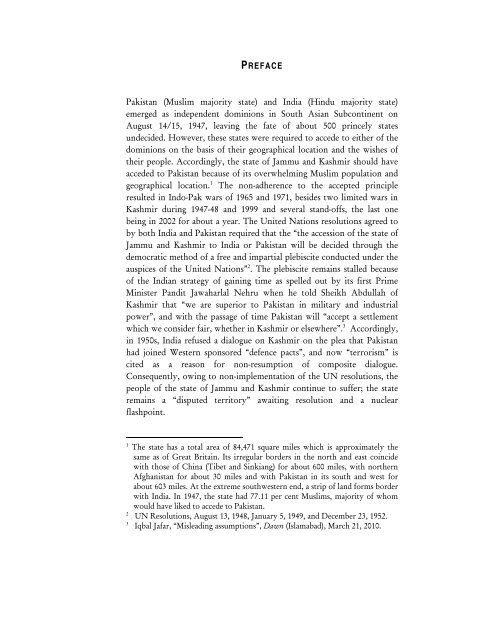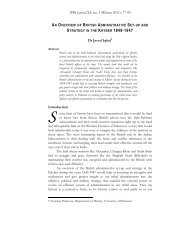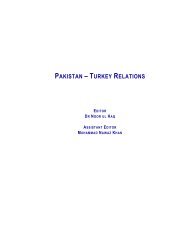120 Whither Kashmir? (Part II) - Islamabad Policy Research Institute
120 Whither Kashmir? (Part II) - Islamabad Policy Research Institute
120 Whither Kashmir? (Part II) - Islamabad Policy Research Institute
You also want an ePaper? Increase the reach of your titles
YUMPU automatically turns print PDFs into web optimized ePapers that Google loves.
4 IPRI Factfile<br />
PREFACE<br />
Pakistan (Muslim majority state) and India (Hindu majority state)<br />
emerged as independent dominions in South Asian Subcontinent on<br />
August 14/15, 1947, leaving the fate of about 500 princely states<br />
undecided. However, these states were required to accede to either of the<br />
dominions on the basis of their geographical location and the wishes of<br />
their people. Accordingly, the state of Jammu and <strong>Kashmir</strong> should have<br />
acceded to Pakistan because of its overwhelming Muslim population and<br />
geographical location. 1 The non-adherence to the accepted principle<br />
resulted in Indo-Pak wars of 1965 and 1971, besides two limited wars in<br />
<strong>Kashmir</strong> during 1947-48 and 1999 and several stand-offs, the last one<br />
being in 2002 for about a year. The United Nations resolutions agreed to<br />
by both India and Pakistan required that the “the accession of the state of<br />
Jammu and <strong>Kashmir</strong> to India or Pakistan will be decided through the<br />
democratic method of a free and impartial plebiscite conducted under the<br />
auspices of the United Nations” 2 . The plebiscite remains stalled because<br />
of the Indian strategy of gaining time as spelled out by its first Prime<br />
Minister Pandit Jawaharlal Nehru when he told Sheikh Abdullah of<br />
<strong>Kashmir</strong> that “we are superior to Pakistan in military and industrial<br />
power”, and with the passage of time Pakistan will “accept a settlement<br />
which we consider fair, whether in <strong>Kashmir</strong> or elsewhere”. 3 Accordingly,<br />
in 1950s, India refused a dialogue on <strong>Kashmir</strong> on the plea that Pakistan<br />
had joined Western sponsored “defence pacts”, and now “terrorism” is<br />
cited as a reason for non-resumption of composite dialogue.<br />
Consequently, owing to non-implementation of the UN resolutions, the<br />
people of the state of Jammu and <strong>Kashmir</strong> continue to suffer; the state<br />
remains a “disputed territory” awaiting resolution and a nuclear<br />
flashpoint.<br />
1 The state has a total area of 84,471 square miles which is approximately the<br />
same as of Great Britain. Its irregular borders in the north and east coincide<br />
with those of China (Tibet and Sinkiang) for about 600 miles, with northern<br />
Afghanistan for about 30 miles and with Pakistan in its south and west for<br />
about 603 miles. At the extreme southwestern end, a strip of land forms border<br />
with India. In 1947, the state had 77.11 per cent Muslims, majority of whom<br />
would have liked to accede to Pakistan.<br />
2 UN Resolutions, August 13, 1948, January 5, 1949, and December 23, 1952.<br />
3 Iqbal Jafar, “Misleading assumptions”, Dawn (<strong>Islamabad</strong>), March 21, 2010.




